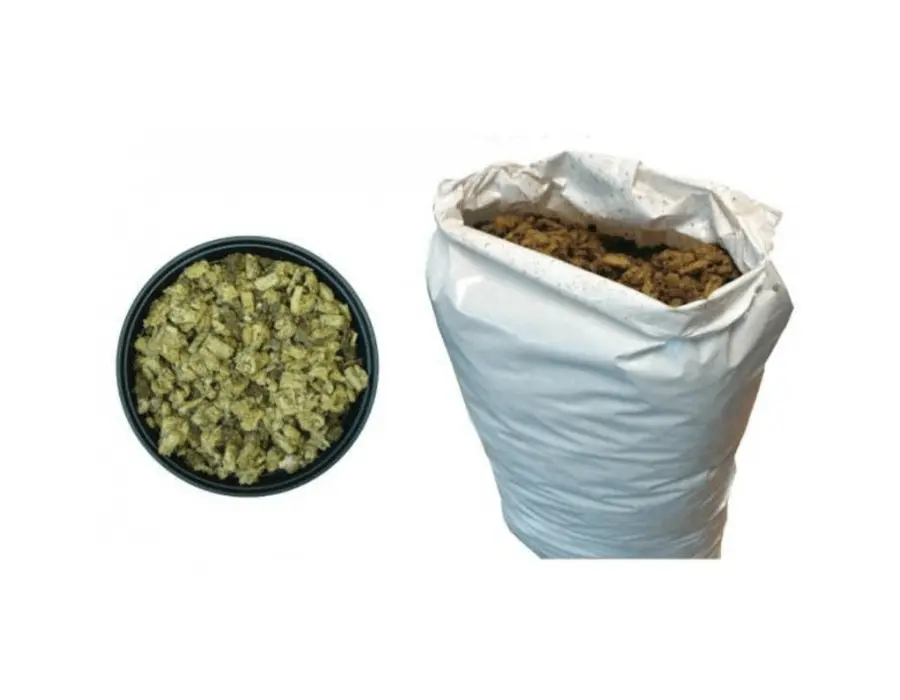Disadvantages of Mapito Substrates
No Buffering Capacity
Due to the inert components in the medium, there is no buffering mechanism for stabilizing pH levels. As with all things cannabis, pH balancing is essential for optimal plant growth. Similarly, electric conductivity (EC) in a soluble solution may fluctuate without a buffer.
While all mediums must be monitored for pH and EC levels when growing cannabis in hydroponic systems, inert materials require strict attention to detail to keep parameters within range.
Soak Mapito Before Planting
Mapito must be soaked in water before use to increase water retention capacity. If the medium is not thoroughly drenched, it is unable to retain moisture efficiently. This effect can result in improper water and nutrient uptake throughout plant development.
The soaking also cleans mapito of any impurities such as excess salts or other chemical imbalances. A minimal 24-hour soak is recommended to thoroughly cleanse the substrate of any contaminants.
Best Practices for Growing Cannabis in Mapito
Easy DIY Soaking Instructions for Mapito
Fill a large bucket with enough water to submerge the mapito. It will absorb water readily, so keep liquid levels above the substrate. Check the pH and EC levels of the water before adding the mapito. This data gives a good base for additive requirements after the mapito is introduced to the water.
The pH will fluctuate during the substrate soaking period. A good rule of thumb is to stabilize the pH around 6.0 in the beginning. As the rock wool and polyurethane components become saturated, pH levels will stabilize.
Unfortunately, the pH may not fall in the ideal hydroponic parameters of 5.5 – 6.0 after the 24-hour soak. pH Up (potassium carbonate or potassium hydroxide) or pH Down (phosphoric acid) products are added to the bath to adjust pH levels accordingly.
Adjust EC levels between 0.3 – 0.4 during mapito soaking. If EC levels are high initially from the water source, distilled water or a reverse osmosis set-up may be required. Check the EC every couple of hours and record changes. Unfortunately, if the EC is above 0.4 after 12 – 15 hours, drain all water from the substrate and re-soak with fresh water.
Filling the Plant Pots
After stabilization at the above-recommended pH and EC levels, fill plant pots to the rim with the soaked mapito. The saturated medium will begin draining, subsequently settling into the new environment. Due to its composition, the growing media will seem light and airy even when drenched.
The substrate will shrink as it dries out, leaving a large void at the top if not filled adequately.
Apply light pressure to squeeze excess water out, although a natural drying process ensures the substrate will perform optimally. Mapito is resistant to compaction, allowing for expansive root growth with ample oxygen availability in the porous substrate.
Capture run-off from one or two pots and measure pH and EC. These early recordings establish a base to grow on.
Growing a Cannabis Plant in Mapito
Whether starting a favourite cultivar from a tiny cannabis seed or encouraging rapid root growth from a fresh clone cutting, mapito provides a stable environment for early marijuana plant development. Maintaining pH and EC levels during the start of vegetative growth encourages the young plant to perform well.
As with all indoor hydroponic set-ups, the grower controls the system. If you want to flip a vibrant marijuana plant into the flowering stage a few weeks into veg, simply change the grow light cycle to 12-12. Mapito easily adapts to pH and EC incremental changes as the cannabis plant matures in growth development.
Growing in mapito for the first time is similar to other hydroponic substrates. However, due to the rock wool – polyurethane structure, abundant oxygen is pumped through the root system. The highly oxygenated substrate encourages both photosynthesis and transpiration.
When expedited water and nutrient fortification is available for plant uptake, canna plant growth excels to new heights. Dutch growers who first began experimenting with mapito boasted a ten-fold yield increase with accented flavour and potency effects.
Planning for a Mapito Grow
The cool thing about growing cannabis is – just when you think you’ve got the process figured out, something new comes along. Who would have imagined cannabis grown in polyurethane back in the early days? It just goes to show – you never know it all, especially when it comes to this divine plant species.
